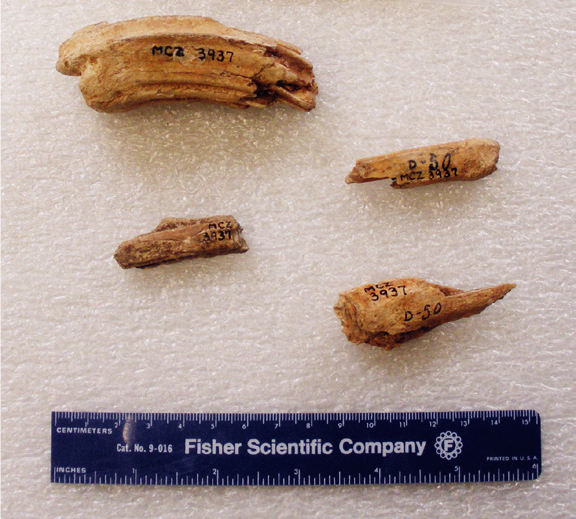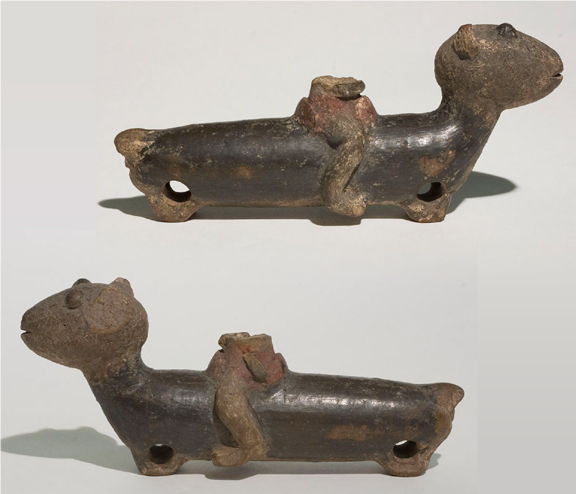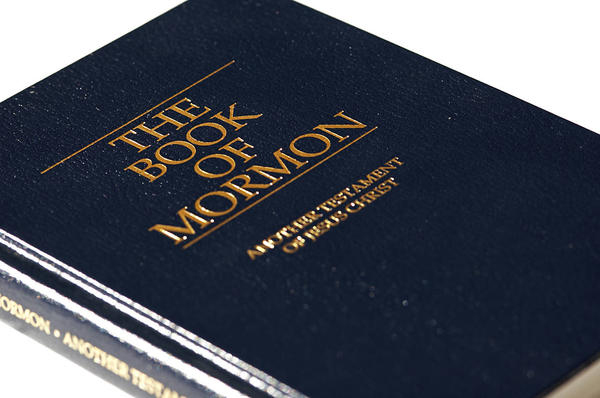
The Know
As Enos describes Nephite life in his day (fifth century BC), he says that they raised “many horses” (Enos 1:21). The mention of horses among domesticated animals kept by Book of Mormon peoples has raised questions in some people’s minds, due to the prevailing view that horses were not found in the Americas during pre-Columbian times. Horses are mentioned only on a few occasions in the Book of Mormon (the last mention is around the time of Christ):
- Horses are mentioned once, in Moroni’s retelling of the record of Ether, as one of the animals that were “useful unto man” among Jaredites during the reign of Emer (Ether 9:19)
- Nephi mentions wild horses among animals found on arrival in the Promised Land (1 Nephi 18:25)
- Enos says that in his time, the Nephites raised “many horses” (Enos 1:21), but how and why they were used is not mentioned
- King Lamoni had horses which Ammon and other servants prepared for a royal procession (Alma 18:9–10,12; 20:6)
- Horses were included among the livestock and provisions the Nephites took when they left Zarahemla and withdrew for seven years into a more secure site as a defensive tactic against the Gadianton Robbers (3 Nephi 3:22; 4:4; 6:1)1
In this small handful of references, no text ever says that horses were ridden or used in battle. They are sometimes mentioned with chariots, but are never actually described as pulling them. It is hard to determine exactly what kind of role they played in the daily life of Book of Mormon peoples except to say that they were “useful.”
In 3 Nephi 4:4, horses are mentioned as being among the provisions “reserved for themselves … that they might subsist for the space of seven years.” The word "subsist" may imply that horses in that desperate time were used for food. Fortunately, the Nephites were successful in their defensive strategy and were eventually able to return to their own lands, "every man, with his family, his flocks and herds, his horses and his cattle, and all things whatsoever did belong unto them" (3 Nephi 6:1). These limited details seem to allow Brant Gardner’s observation, “The Book of Mormon ‘horse’ never fulfills the functions we expect of a horse.”2
Readers can interpret the presence of horses in the Book of Mormon in a variety of different ways.
1. Horses in the Archaeological Record
Perhaps the most straightforward approach is to assume that horses, which subsequently became extinct, were available in the area in which the Nephites and Lamanites lived. It is not unusual for primary source documents to mention things which archaeologists cannot prove. In fact, it is expected that authentic documents will give us new information about the past.3
Some evidence may indicate the presence of horses in America in pre-Columbian times. Dr. Wade Miller, an internationally respected geologist and paleontologist, ran Carbon-14 tests on several horse specimens found at archaeological sites throughout the Americas. Preliminary results have returned various dates from about 6000 BC to AD 1400.4 Daniel Johnson has collected and summarized the evidence for horses in ancient America. His data analyzes the anomalous dating of horse bones, art works, and the variety and distribution of horses in early post-Columbian times.5
2. Nephi Could Have Borrowed the Word "Horse"
Another approach to this question suggests that the word “horse” in the Book of Mormon is being used to refer to a different animal. Throughout history, when immigrants and travelers have encountered new, unfamiliar species, they have often applied labels from their own language which originally referred to different animals.6 In many cases, the borrowed term has become the common name.
For example, the Greeks coined the name hippopotamus, which literally means “river horse.”7 The American bison is still colloquially called buffalo—which technically refers to a different species—a practice that started with the French trappers who first explored the American West. The terms elk and robin were also applied to American animals by Europeans, even though they are used in reference to totally different species in the Old World.
Relevant to the issue of horses in the Book of Mormon is the linguistic confusion that the horse caused when the Spanish first arrived. Different Maya and Aztec groups applied their labels for deer or tapir to the Spaniards’ horses, lacking a better word.8 Perhaps Book of Mormon peoples made the same connection in reverse, applying their Old World term for “horse” to some other species.
3. "Horse" could be a Result of Translation

It is also possible that “horse” is a “translator anachronism.” Brant Gardner explains, “We need look no further than the King James translation of the Bible for examples of anachronisms that occur only in translation and not in the text being translated.” One prominent example is the mention of candles, which were not invented in biblical times, though the term is used in reference to oil lamps. “Thus, the word candle is an anachronism, but only in the translation.”9
Without the original text, it is impossible to be sure whether “horse” is a loan-shift the Nephites made or an anachronism caused by translation, but in either case the word “horse” would not refer to what today’s readers might assume or expect. One should be aware of these possibilities while reading references to horses and other plants and animals not commonly thought to be in the Americas during Book of Mormon times.
The Why
Why horses are mentioned in the Book of Mormon is unstated. How they were used, when, and by whom, is left unsaid. Indeed, needing to say that they were useful on some occasions seems to imply something remarkable or unusual, otherwise the point would not need to be mentioned. In fact, in many cultures and on various topographies, horses are not useful, being hard to tame and costly to maintain.
While there is no definitive answer to why horses are mentioned in the Book of Mormon, each of these prospects creates room for further exploration, wondering, understanding, and especially faith. Each possible explanation also teaches important lessons about archaeology, ancient writings, and translations that need to be taken into account when considering information, insights, questions, and curiosities about the Book of Mormon.
1. Be Patient with the Archaeological Record
First, it is best to be patient with the archaeological record. There is still much work to be done, and lots to be learned about life in pre-Columbian America. The vast majority of Mesoamerican ruins remain untouched underneath thick jungle growth,10 and other areas in the Americas have received even less attention. Also, the preservation of animal bones is very poor in the humid jungles of Mesoamerica.11 Since the Book of Mormon text mentions horses rarely, the likelihood of finding bones or other remains of their horses becomes even more remote.
Still, several items mentioned in the Book of Mormon once considered anachronistic have since been verified.12 This is why John E. Clark, a Latter-day Saint and prominent Mesoamerican archaeologist, declared: “the Book of Mormon looks better with age.”13 Such findings should urge caution against making final judgments based on absence of evidence.
2. Book of Mormon Peoples, Unsurprisingly, Acted Like Real People
Second, Book of Mormon peoples should be expected to act and behave just as real people have throughout history. It is likely that, on arrival, Nephi had the same problem as many others have historically when encountering new species in the Promised Land. Hence, anthropologist and Book of Mormon scholar John L. Sorenson explained, “the Lehites would have followed [common naming practices] … in adapting their Hebrew nomenclature to apply to the new fauna they encountered.”14
3. A Divine Translation Should be a Real Translation
Finally, even a divine translation should be treated as a real translation, with all the complications that are attendant to rendering a text into a new language. Having carefully studied the translation of the Book of Mormon, Brant A. Gardner offers this important caution: “the very fact that we have the Book of Mormon in translation requires that we look at anachronisms in the text carefully. … In the vast majority of the cases, it is reasonable that we are seeing a translation anachronism rather than a historical anachronism.”15 Ultimately, any translation, but especially a divine translation, may purposefully and beneficially invite its readers to wonder about many things, thus encouraging them to further study while allowing them to exercise faith when confronting questions.
Further Reading
Brant A. Gardner, “Anachronisms in the Book of Mormon,” in A Reason for Faith: Navigating LDS Doctrine and Church History, ed. Laura Harris Hales (Salt Lake City and Provo, UT: Deseret Book and Religious Studies Center, Brigham Young University, 2016), 33–43.
Daniel Johnson, “‘Hard’ Evidence of Ancient American Horses,” BYU Studies Quarterly 54, no. 3 (2015): 149–179.
John L. Sorenson, Mormon’s Codex: An Ancient American Book (Salt Lake City and Provo, UT: Deseret Book and Neal A. Maxwell Institute for Religious Scholarship, 2013), 309–321.
Wade E. Miller, Science and the Book of Mormon: Cureloms, Cumoms, Horses & More (Laguna Niguel, CA: KCT & Associates, 2010).
- 1. Horses are also mentioned in 2 Nephi 12:7; 15:28; 3 Nephi 21:14, but all three of these are quotations of biblical scripture (Isaiah 2:7; 5:28; Micah 5:10).
- 2. Brant A. Gardner, The Traditions of the Father: The Book of Mormon as History (Salt Lake City, UT: Greg Kofford Books, 2015), 291. See the similar observations made by John L. Sorenson, Mormon’s Codex: An Ancient American Book (Salt Lake City and Provo, UT: Deseret Book and Neal A. Maxwell Institute for Religious Scholarship, 2013), 315.
- 3. Stephen D. Ricks, review of Lehi in the Deseret, The Collected Works of Hugh Nibley: Volume 5, by Hugh Nibley, Review of Books on the Book of Mormon, 2 (1990): 139–140, explained: “To accept only those elements of the Book of Mormon—or any other document, for that matter—that accord with what is already known is to refuse it any primary evidentiary value and to render the Book of Mormon—or any other document—superfluous.” Ricks also adds: “Yet each new document of religious content has changed our perception of the ancient religious world, often radically: the Ugaritic tablets have given us our first detailed glimpse into the Canaanite pantheon by ‘true believers,’ the Dead Sea Scrolls are the first documents written by actual Essenes, the Nag Hammadi codices provide insights into, among other matters, Gnosticism so called, by adherents rather than opponents” (p. 140). Dana M. Pike, “Israelite Inscriptions from the Time of Jeremiah and Lehi,” in Glimpses of Lehi’s Jerusalem, ed. John W. Welch, David Rolph Seely, and Jo Ann H. Seely (Provo, UT: FARMS, 2004), 195, explained: “because of its vast size and the great span of time it covers, the Bible preserves historical, cultural, and religious data that would otherwise be unknown if we had only the relatively small corpus of ancient Israelite inscriptions.” The Book of Mormon also covers a vast time span, and so would likewise have historical information unknown through other forms of evidence. J. Maxwell Miller and John H. Hayes, A History of Ancient Israel and Judah, 2nd ed. (Louisville, KY: Westminster/John Knox Press, 2006), 45: “Archaeology is most useful for understanding the physical environment of a region and recognizing broad trends in its material culture. Archaeology is less helpful, unless coordinated with written records, for determining the ethnic identity of the people who lived in the region or dealing with the specifics of their history.”
- 4. Wade E. Miller, Science and the Book of Mormon: Cureloms, Cumoms, Horses & More (Laguna Niguel, CA: KCT & Associates, 2010), 82.
- 5. Daniel Johnson, “‘Hard’ Evidence of Ancient American Horses,” BYU Studies Quarterly 54, no. 3 (2015): 149–179. Also see the short note, “Once More: The Horse,” in Reexploring the Book of Mormon: A Decade of New Research, ed. John W. Welch (Salt Lake City and Provo, UT: Deseret Book and FARMS, 1992), 98–100.
- 6. Brant A. Gardner, Second Witness: An Analytical and Contextual Commentary on the Book of Mormon, 6 vols. (Salt Lake City, Utah: Greg Kofford Books, 2007–2008), 1:324–326 offers a good discussion of this issue. Gardner succinctly explains, “In any case, the encounter with completely new animals (and plants) creates a linguistic crisis. One solution has typically been to adapt an old designation to the new animal, even when there is no biological connection. The connection is based on some perceived similarity even though those with a knowledge of both animals might not see it” (p. 325).
- 7. The Greek historian Herodotus (Histories 2.71.1), for instance, spoke of “river horses” (hippopotami) that he saw swimming in the Nile as he traveled through Egypt. So striking to Herodotus was the resemblance of these heretofore unknown creatures that he even commented on their manes, tails, and voices being like that of a horse. See Stephen Smoot, “A Recent Experience with a Greek Manuscript,” at Ploni Almoni, January 9, 2015 (accessed March 7, 2016).
- 8. See John L. Sorenson, An Ancient American Setting for the Book of Mormon (Salt Lake City and Provo, UT: Deseret Book and FARMS, 1985), 296; Sorenson, Mormon’s Codex, 313, 318–319; Neal Rappleye, “Tzimins are not Really Tzimins (They’re Horses),” at Studio et Quoque Fide, June 23, 2015 (accessed March 5, 2016).
- 9. Gardner, The Traditions of the Father, 292.
- 10. Mark Alan Wright, “The Cultural Tapestry of Mesoamerica,” Journal of the Book of Mormon and Other Restoration Scripture 22, no. 2 (2013): 6: “Literally thousands of archaeological sites dot the Mesoamerican landscape, the vast majority of which we know virtually nothing about, other than their locations. In the Maya area alone are approximately six thousand known sites, of which fewer than fifty have undergone systematic archaeological excavation …. Archaeologists estimate that less than 1 percent of ancient Mesoamerican ruins have been uncovered and studied, leaving much yet to learn.”
- 11. Amber M. VanDerwarker, Farming, Hunting, and Fishing in the Olmec World (Austin, TX: University of Texas Press, 2006), 117; Miller, Science and the Book of Mormon, 28–29.
- 12. For several examples, see “Howlers Index,” at Ether’s Cave, (accessed March 7, 2016). Also see Kevin Christensen, “Hindsight on a Book of Mormon Historicity Critique,” FARMS Review 22, no. 2 (2010): 155–194; John E. Clark, “Archaeological Trends and the Book of Mormon Origins,” in The Worlds of Joseph Smith: A Bicentennial Conference at the Library of Congress, ed. John W. Welch (Provo, UT: BYU Press, 2006), 93–95.
- 13. Clark, “Archaeological Trends,” 94. Clark also explained: “These deficiencies of negative evidence persist, for the most part, but they should not distract from the scores of other unusual items mentioned in the book which have been confirmed through archaeology—nor from the possibility that missing evidence may someday be found” (p. 95).
- 14. Sorenson, Mormon’s Codex, 319. Also, “after their arrival they reported the presence of native fauna to which they applied the names of Near Eastern animals that looked similar” (p. 35).
- 15. Brant A. Gardner, “Anachronisms in the Book of Mormon,” in A Reason for Faith: Navigating LDS Doctrine and Church History, ed. Laura Harris Hales (Salt Lake City and Provo, UT: Deseret Book and Religious Studies Center, Brigham Young University, 2016), 41. For his full analysis of the translation, see Brant A. Gardner, The Gift and Power: Translating the Book of Mormon (Salt Lake City, UT: Greg Kofford Books, 2011).
Continue reading at the original source →








